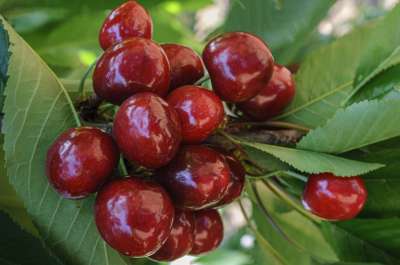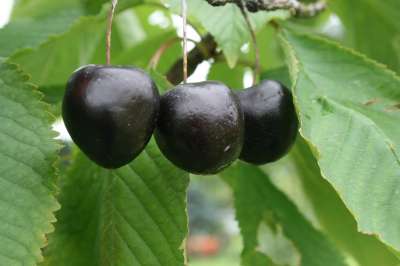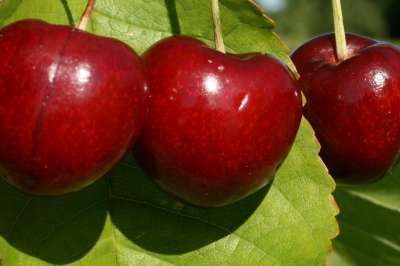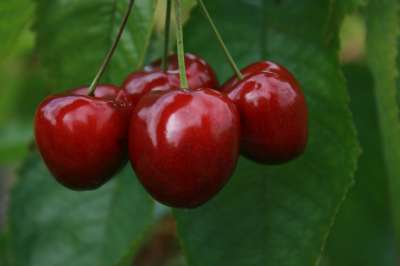Your basket is currently empty!
Why should you grow your cherry tree in a fruit cage?
Buy quality cherry trees on dwarfing stocks.
If you’re lucky enough to have a fruit cage no doubt you’re already well aware that it can never be big enough to realise all your dreams and that it would probably need elastic sides to accommodate even a fraction of all the things you would like to grow in it…… the list of fruits that would benefit the most from inclusion is a long one – strawberries, raspberries, blueberries, redcurrants, loganberries and tayberries, plums – and – cherries. If I had to put one at the top of the list it would undoubtedly be a cherry.
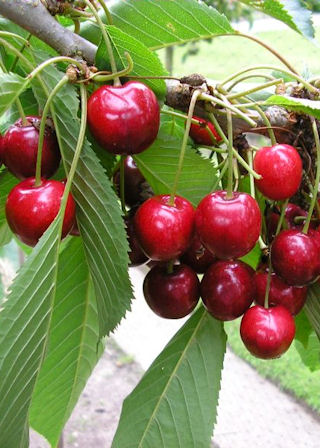
Our feathered gardening friends have a liking for all kinds of fruits, especially the red ones. But if they were able to tell you what their absolute favourite is, I bet it would be cherries! They don’t even wait for them to ripen properly on the tree – one moment all those valuable fruits hang green and burgeoning, maybe one or two just beginning to turn colour – and then seemingly overnight they’re all gone! The birds will rise much earlier than you will so unless you are a true ‘early bird’ as well you probably won’t even see it happen, the bountiful harvest just disappears as if by magic and they pluck them from the tree and devour whole, not like strawberries for example where they browse from one fruit to the next, taking chunks out and leaving the mess behind.
Although undoubtedly the sweet cherry will be more attractive to them, Morello cherries alas are also well liked and will go the same way.
A few years ago it wasn’t easy to accommodate cherries into fruit cages because a lot of the old stocks that were most often used were far too vigorous and would outgrow a 6’ height fruit cage in about a year! Nor were they tolerant of heavy pruning, the result of which is usually a mass of even more vigorous shoots and no fruit. Luckily, in the last 5-10 years there has been advancements in the breeding and selection of cherry rootstocks and there are now smaller growing and even dwarf options that fit happily into smaller spaces – including the fruit cage.
Tabel was first out of the blocks and for a while it was popular and satisfactory as a garden cherry tree, but it had it’s drawbacks. For some it was simply too dwarfing and didn’t seem to want to grow at all. As a commercial nursery prospect it was a disaster too as the trees that were being supplied on this rootstock were often of woeful quality. It has largely disappeared from lists now and has quickly been replaces by the Gisela range of cherry rootstocks.
Dwarfing stock cherries for the fruit cage
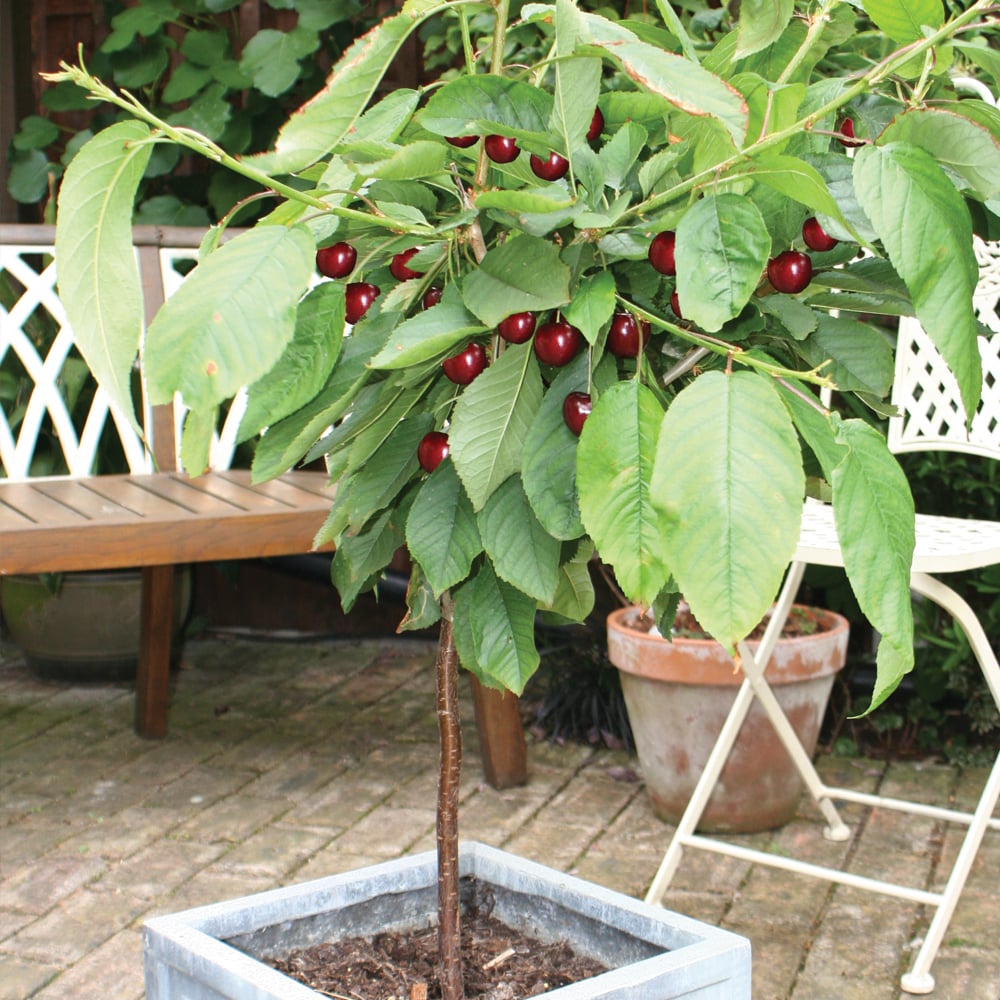
Buy Sunburst sweet dwarf cherry tree here
Gisela 5 is by far the most popular – and the smallest – but is actually only part of a range of numbered Gisela stocks. But as far as the gardener is concerned Gisela 5 is ‘the’ one and Gisela 6 the only other stock you might find. The latter is a tad more vigorous but still on the compact side so useful if you want something in between – it can be controlled for fruit cage height and bears productively.
Gisela 5 is small – easily kept to within 6-8’ with pruning. It likes good soil – most dwarfing rootstocks do – and will benefit from good soil preparation beforehand. Don’t try to grow Gisela 5 on light or poor soils as it will be a wasted investment both in time and monetary terms but aside from this I offer no caution, it’s a highly satisfactory rootstock, fast into production, usually beginning to fruit within 2 years, and the weight of crop is pretty impressive for a small tree, 10 ibs or more with the better varieties.
If we go back to before the Gisela’s then we come to Colt which has for a long time been the most favoured garden rootstock for Cherries and it too can be accommodated in a fruit cage, left untended it will make a tree of 10’ or more but with selective pruning it can be kept within the dimensions of a fruit cage with some ease. It’s also the best rootstock for fan training or festooning.
Methods of Growing for Restricted Growth
The easiest and most oft used is the small bush tree and this is the method that suits Gisela 5. With the normal pruning involved for all cherry trees it will give a tree of around 6’ in height and you will need to allow the same in width. Pruning is fairly simple, with young 1 year trees being cut back by about a third after planting. This facilitates better branching, with a number of side branches being produced as well as a new leader which will form immediately below the cut. This, any other strongly upward growing branches, are similarly reduced again, by a third, the next year. Bush trees on Gisela 5 stock start to crop in 2 years usually.
Column trees
Column trees are immensely popular, infact probably the most popular for garden growing of cherries, and they incorporate ideally into the fruit cage as well, they take up very little space so you won’t be gobbling up too much of your precious room! A column cherry will be supplied on the Gisela 5 rootstock but it is grown as a single straight stem. Side laterals are kept pruned right back, so you only need about 18” in which to grow on, which would probably allow you to mplant multiple trees without too much strain on those elastic sides. Pruning is incredibly simple so if you have a secateurs phobia don’t break into a sweat. Just tip all the side shoots back to a couple of buds in late Summer. That’s it – prune the top leader back as necessary. The fruits are borne on the short side spurs you have just created. Column trees are pretty precocious too, and usually start to crop within 2 seasons, maybe even the next summer following planting if you are lucky.
Fan training
Fan training is an attractive method usually reserved for a wall or fence, but it does not have to be so – you can fan train a cherry in a fruit cage, you can utilize one end of the cage itself or erect a post and wire system to train it against, either way support is required, you can’t fan train a tree free standing. Colt is the stock used for fan training, we often get requests for dwarf fans but this isn’t a very satisfactory combination as a dwarfing tree doesn’t have sufficient growth potential to make a good fan, besides which fan training is in itself a restrictive growing method, so you don’t need ads much room as you might think. A width space of 6-8’ is enough, and about 6’ in height too, which is obligingly, just about the height of an average fruit cage. The flat shape of a fan trained tree allows all the light and sunshine to penetrate so the fruits are extra sweet and colour up well. Fan training can be a daunting challenge to the less experienced, but needn’t be so. In simple terms what you are doing is hard pruning a young tree in the first winter, so you have an alarmingly unpromising stump of about 18” sitting in the ground. Despite your reservations, this ‘stump’ will produce lots of strongly upward growing new growths which are quite flexible – you can either select 5 or 6 and ‘fan’ them out straight away, or you can just choose two of the most horizontal ones, discard the rest, and allow the two horizontals to produce new vertical shoots.
Festooning
Festooning is quite an old method and not one that is used that often but it’s easy and makes an attractive tree ideally suited to a fruit cage so it’s worth considering. Festooning involved bending the leader of a flexible young maiden tree gently downwards and tieing in a semi-weeping position to a peg in the ground. The stronger side laterals are treated in the same way as well as selected resulting growths from the leader itself. This weeping type tree is novel and attractive and for some reason seems to have the effect of inducing earlier and productive fruiting. After 3 or 4 years the pesga dn ties can be removed and the tree will stay in that weeping position, by which time a lot of the stronger growing will have ceased so you can be selective with what new growths you get, keeping and tieing them down or removing them. Well worth a thought and not too difficult to do. You must only use Colt stock for festooning and it can easily be kept to 6’ height or a little less – ideal dimensions for a fruit cage. The width will be about the same.
Variety selection.
My recommendations for growing a fruit cage would differ little than for those grown in the open except the emphasis is even more heavily biased towards the self fertile varieties which are simply better varieties and more reliable. Additionally, the Gisela 5 rootstock is still largely in short supply as far as the nursery trade is concerned and so we tend to concentrate on grafting the better and more popular varieties onto rootstocks when they are in demand. The older, heirloom and specialist varieties tend to be reserved for the bigger stocks that are always plentiful. So you may only be able to find types such as Stella, Sunburst or Lapins, as well as Summer Sun and the cooking variety Morello, on Gisela 5 stock. If you’re fan training on Colt then the choice may be wider but those varieties mentioned are simply good, trouble free varieties more likely to provide you with quality fruit.
Pollination is a tricky subject within Cherries and matching up non self fertile varieties can be hazardous so additionally, by keeping to known self fertile ones, the headache of choosing correct partnerships is avoided. They all tend to be red/black varieties, big, sweet and of good quality. If you have a liking for ‘white’ cherries, or you are growing a selection and what to provide some variation, then the older Merton Glory, or the newer Vega, are both good choice – but neither is self pollinating so they will need a partner – again you can choose any self fertile variety to do this.
For cooking varieties Morello remains the first, and often the only, choice. Cooking [also known as acid] cherries tend to be hardier and more forgiving than sweet cherries so if you have a shady end to your fruit cage, or garden in a colder locality t’s well worth planting a Morello for failsafe results.
Further notes
Avoiding fruit drop in Cherries can be problematic, this troublesome occurrence happens with half grown or smaller cherries suddenly fall from the tree, seemingly for no good reason. Sometimes a run of cold nights can bring it on, sometimes high winds can remove them, but most often it is irregular water supply. Too little or too much following too little will reduce the amount of fruits than make it to maturity. And lastly a tree may not be able to carry it’s optimum crop to the final stages if it is over-producing, especially so on younger less established trees.
So you have various courses of action; keep an eye on your trees and if they seem to be getting a bit over ambitious then don’t be afraid to thin some of the fruits when about pea sized. This might seem like a shame, wilfully sacrificing some of your hard earned crop, but it will pay dividends later on – the fruits will be bigger and juicier and the tree will be more likely to keep them all.
Additional watering during dry spells, especially early on in May and June, is crucial in order to develop good quality fruits. Water at the base of the tree, on early morning or the evening and apply a mulch of organic material too to try and conserve moisture and stop the soil beneath getting too hot where the sun strikes it.
Staking for small trees is advantageous, even in the confines of a fruit cage and is especially important fort dwarfing trees that have smaller roots and may become wind rocked over winter, or even in the summer when laden with leaf and fruit and the wind catches them. Inserting the stake [about 2 x 2”] at planting is better than doing it afterwards, and secure with rubber tree ties. Rubber avoids chafing and won’t cut into the bark of the trunk as it grows, but still make sure the tie is loosened each year so it doesn’t restrict the tree.



